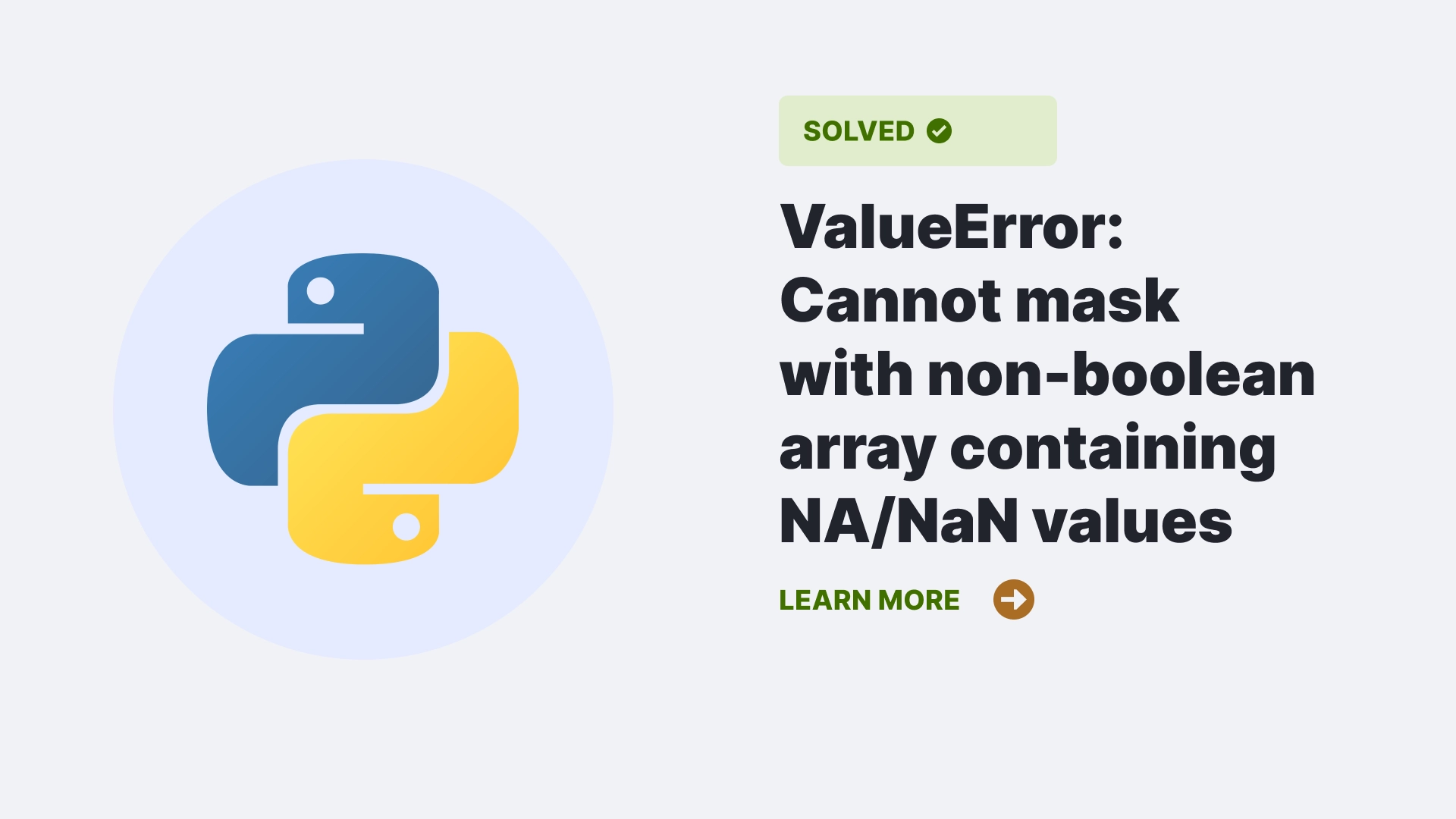The error message “ValueError: Cannot mask with non-boolean array containing NA/NaN values” typically occurs when attempting to use a non-boolean array with missing or NaN (Not a Number) values as a mask. In NumPy or pandas, masking is often done using boolean arrays, where each element is either True or False, to filter or manipulate data. The frequency of occurrence of this error depends on the specific data and operations we are performing.
It is more likely to happen when working with arrays or data structures that may contain missing or NaN values. For example, if we have an array with a significant number of missing values or if we are performing operations that involve filtering based on conditions that include NaN values, we may encounter this error more frequently.
Contents
Steps to resolve the ValueError: Cannot mask with non-boolean array containing NA/NaN values error:
To resolve this issue, we need to ensure that the mask is a boolean array and does not contain any missing or NaN values. Here are a few steps that can be taken:
Check the array or DataFrame that we are using as a mask for any missing or NaN values. We can use functions like numpy.isnan() or pandas.isna() to identify these values.
Once we have identified the missing or NaN values, we can either remove those rows or fill them with appropriate values depending on our use case. For example, we can use the numpy.isnan() or pandas.isna() functions to create a boolean mask and then use it to filter out the missing or NaN values.
Alternatively, we can use functions like numpy.where() or pandas.DataFrame.where() to perform conditional operations on the data, where the mask is based on boolean conditions rather than direct masking.
Here’s an example of how we can create a boolean mask using NumPy and handle missing or NaN values. In this example, the ~ operator is used to invert the boolean values of the mask. Then, the mask is applied to the array using arr[mask], resulting in filtered_arr that contains only the non-missing/non-NaN values.
Syntax:
pythonCopy codeimport numpy as np
# Example array with missing or NaN values
arr = np.array([1, 2, np.nan, 4, 5])
# Create a boolean mask without missing or NaN values
mask = ~np.isnan(arr)
# Apply the mask to filter out missing or NaN values
filtered_arr = arr[mask]Here is an example to illustrate using pandas. In this example, the notna() function is used to create a boolean mask where True corresponds to non-missing/non-NaN values. Then, the mask is applied to the DataFrame using df[mask], resulting in filtered_df that contains only the rows without missing or NaN values.
It needs to be remebered to adjust the code according to the specific data structures and libraries you are using (e.g., NumPy, pandas) and the requirements of your scenario.
Syntax:
import pandas as pd
import numpy as np
# Create a DataFrame with missing or NaN values
df = pd.DataFrame({'A': [1, 2, np.nan, 4, 5]})
# Create a boolean mask without missing or NaN values
mask = df['A'].notna()
# Apply the mask to filter out missing or NaN values
filtered_df = df[mask]The situations where the error ‘ValueError: Cannot mask with non-boolean array containing NA/NaN values’ occurs:
Filtering Data: You are trying to filter a dataset or array based on a condition, but the condition involves an array with missing or NaN values. In this scenario, the condition data > 3 results in a boolean array with missing or NaN values. When you try to use this array as a mask (data[condition]), the “ValueError” is raised.
import numpy as np
# Example scenario - Handling missing values in the condition
data = np.array([1, 2, np.nan, 4, 5])
condition = np.logical_and(data > 3, ~np.isnan(data))
# Applying the modified condition as a mask
filtered_data = data[condition]Missing Data Handling: You are using missing or NaN values in an array as a mask for other operations. In this case, the mask df['A'].isna() is applied directly to the DataFrame to filter rows with missing or NaN values. Remember to adjust the code based on your specific requirements and the libraries you are using.
import pandas as pd
import numpy as np
# Example scenario - Handling missing values separately
df = pd.DataFrame({'A': [1, 2, np.nan, 4, 5]})
df_filtered = df[df['A'].isna()]FAQs
What is non-boolean array with NA/NaN values?
A non-boolean array with NA/NaN (Not a Number) values refers to an array that contains missing or undefined values represented by NaN. This array can be of any data type, such as numeric, string, or object, but it includes one or more NaN values.
NaN is a special floating-point value that represents undefined or missing data. It is commonly used to indicate the absence of a value or to represent the result of an undefined mathematical operation.
Conclusion
Hence, the error message “ValueError: Cannot mask with non-boolean array containing NA/NaN values” occurs when you attempt to use an array with missing or NaN (Not a Number) values as a mask, but the mask should be a boolean array.
By ensuring that the mask is a valid boolean array without missing or NaN values, we can avoid the “ValueError” and perform your desired operations on the data successfully.
References
Follow us at PythonClear to learn more about solutions to general errors one may encounter while programming in Python.

